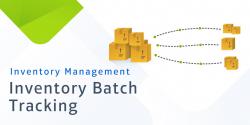Inventory Batch Tracking: Streamline your Inventory Management

To help our community improve the traceability of their inventory, Marello 3 introduces a new feature: batch tracking. With this new feature, users will now be able to assign products to inventory batches. This allows even more accurate inventory visibility and the ability to use Marello in strategies such as LIFO and FIFO as well as for tracking expiry dates.
What is Batch Tracking?
Inventory batches represent a number of inventory items that are received on a specific date, for specific costs. Each batch of inventory, of the same product type, may differ. Think of the expiry date the product has, the color that was used to paint the item, the location the product was made, the purchase price or the type of material that was used.
There are a number of reasons why it is important to know the differences in the products, especially when products are sold to your customers.
Batches will enable you to
- Track expiry dates
- Analyze return rates for certain batches
- Answer customer questions about differences between products
- Make more accurate reports on revenue, profit margin reports, Simple Moving Average (SMA) and more
Furthermore, inventory batches will allow you to set up specific strategies, such as LIFO, FIFO, and FEFO.
Strategies with Inventory Batch Tracking
Smart inventory management is crucial for any product-oriented business. FIFO, LIFO, and FEFO are common inventory methods. The strategy you choose will have profound effects on logistics and profitability. These are the major differences between the three:
FIFO, LIFO, FEFO
A “First In First Out” strategy implies that products that came in first, will move out first. Fifo is mainly used by companies that sell fast-moving products.
“Last In First Out”, means that products that came in last, move out first. Lifo is mainly used in cases where products do not have a shelf life.
The “First Expired First Out” method is used for products that have an expiry date. In this case, the product with the closest expiry date moves out first.
How Batch Tracking works in Marello 3
To understand how Marello 3 allows for inventory batch tracking, let’s take a look at how inventory is tracked:
- Each product type is set as an inventory item
- Each inventory item is assigned an inventory level
Inventory levels are tracked in real-time and determine how many products are available in warehouses. Inventory batches add an extra layer to inventory levels.
- Each inventory level is subdivided into inventory batches
Working with Inventory Batches
Enabling Inventory Batches
For each inventory item, batch tracking can either be enabled or disabled. Once batch tracking is enabled, it cannot be reversed.
Tracking Batches
Inventory batches are updated in real-time. Each time inventory moves, inventory levels in batches will shift. It is possible to see which inventory batches are available in each of your warehouses.
Purchase Orders and Inventory Batch numbers
Inventory Batch numbers are assigned each time new inventory comes in. When inventory is moved to a new location (replenishment), batch numbers will remain assigned to the moving inventory. When the batch number is already known at the new location, the moved inventory batch will be merged. Inventory movements may either come in trough automated processes, by importing files, or by manually adapting inventory batch data.
Batch information
Each batch has its own distinct information. This includes a batch number, purchase price, purchase date, and expiry date.
Setting Inventory Strategies in Marello 3
How to allow for inventory strategies such as FIFO, LIFO, and FEFO in Marello 3?
Warehouse Fulfillment Allocation Rules
Marello includes a comprehensive workflow engine, in which fulfillment rules can be set. In Marello, these are called “WFA Rules” or “Warehouse Fulfillment Allocation Rules”. These rules determine which conditions should be taken into account when assigning inventory to fulfill an order. To allow for FIFO, LIFO or FEFO, rules can be set according to conditions such as “receive date” or “expiry date”. In that way, Marello will always calculate the right inventory to use to fulfill orders, tailored to your preferred strategy.
It is also possible to extend your LIFO, LIFO or FEFO strategy with rules such as first choosing the nearest warehouse and checking the batches in the chosen warehouse.
Some examples of inventory strategies in which Marello checks:
- all available inventory and chooses to fulfill an order with inventory that came in last (LIFO)
- all available inventory and chooses to fulfill an order with inventory that came in first (FIFO)
- all available inventory and chooses to fulfill an order with inventory that has the closed expiry date (FEFO)
- what warehouse is closed to the customer, whether the inventory to fulfill the order is available, and then selects the right inventory according to LIFO, FIFO or FEFO
- what warehouse is capable of fulfilling the whole order (no split-shipment), and then selects the right inventory according to LIFO, FIFO or FEFO
- what warehouses are needed to fulfill the whole order (split-shipment), and then selects the right inventory according to LIFO, FIFO or FEFO in those separate warehouses
Expiry Dates
It is possible to set the WFA rules in such a way that expired items will not be considered in calculating which batch should be used for order fulfillment.
Want to know more?
Got questions about the new inventory batches functionality? Don’t hesitate to reach out! We’d be happy to tell you more.
Back to blog